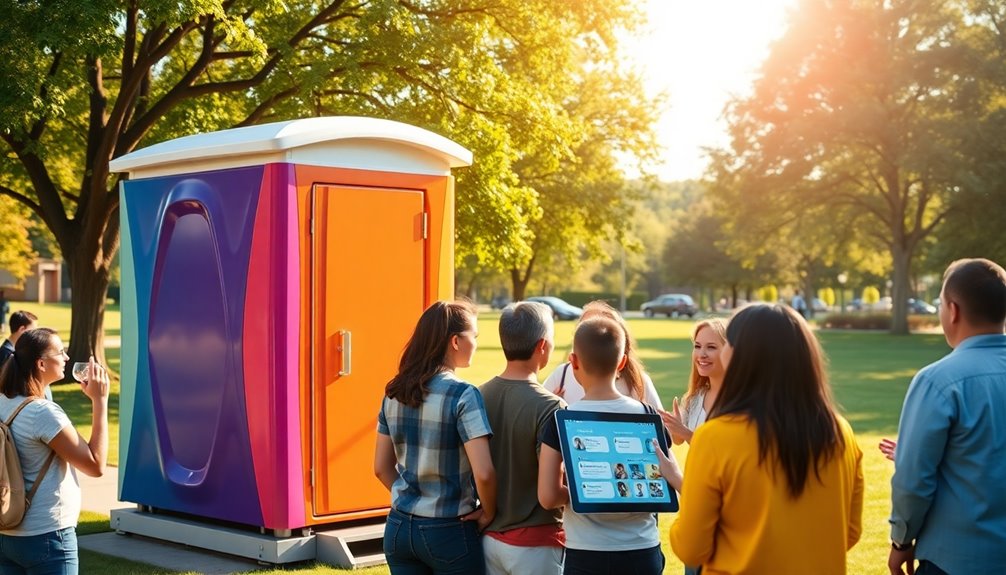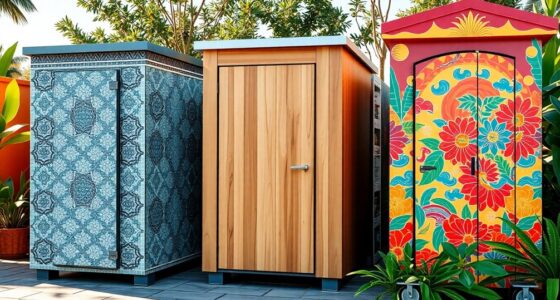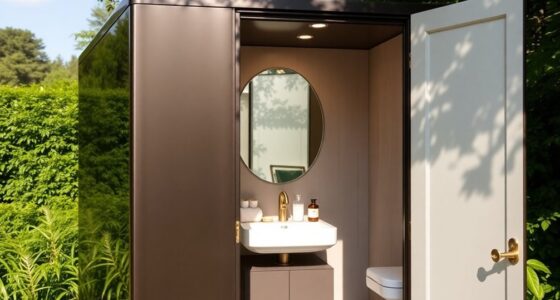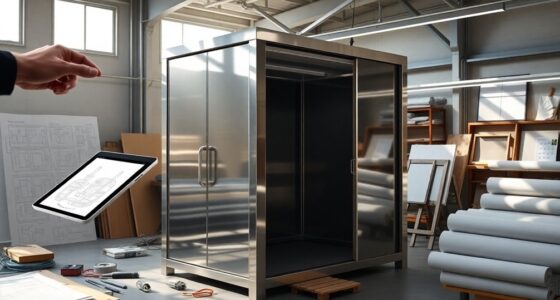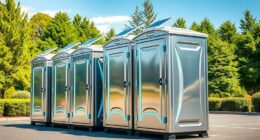User feedback plays a vital role in innovative portable restroom design. It drives enhancements in hygiene, leading to hands-free fixtures and antimicrobial surfaces. You'll notice improvements in user comfort, like spacious interiors and climate control. Accessibility features like ADA compliance and family-friendly options are also prioritized. Demand for eco-friendly solutions has pushed for composting toilets and water-efficient fixtures. There's always more happening in this evolving field, and you'll discover even more exciting trends ahead.
Key Takeaways
- User feedback informs the need for hands-free fixtures, enhancing hygiene and reducing germ transmission in portable restrooms.
- Requests for eco-friendly solutions lead to innovations like composting toilets and water-efficient fixtures for sustainable waste management.
- Insights from users drive the integration of advanced technology, such as real-time monitoring systems and mobile apps for service requests.
- Comfort and accessibility improvements stem from user input, resulting in spacious interiors and ADA-compliant features for diverse needs.
- Demand for enhanced sanitation drives the adoption of antimicrobial surfaces and automatic cleaning systems for better hygiene management.
The Role of User Feedback in Design Evolution
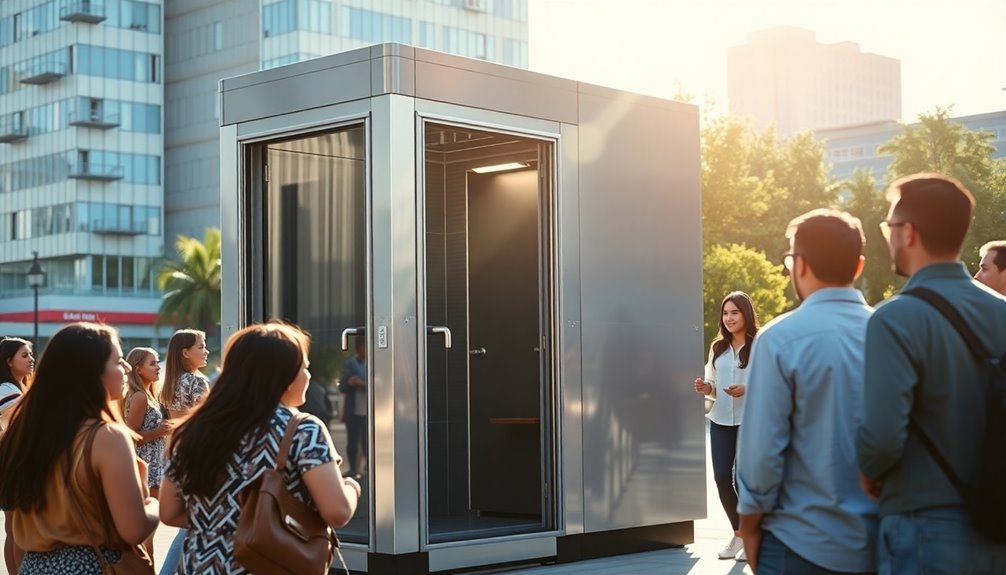
User feedback plays an essential role in the evolution of portable restroom design, as it directly shapes the features and functionality you experience. Your insights have led to modern portable units boasting hands-free fixtures, like sensor-activated faucets and soap dispensers, enhancing hygiene.
This feedback also drives the demand for eco-friendly solutions, resulting in water-efficient fixtures and composting toilets that conserve resources. Innovations aimed at increasing user comfort, such as spacious interiors and climate control systems, stem from your suggestions.
Additionally, real-time monitoring systems and mobile apps for service requests emerged from your desire for convenience. By continuously gathering customer insights, manufacturers guarantee that portable restroom services remain inclusive and accessible, ultimately enhancing your overall user experience.
Key Areas of Improvement Highlighted by Users
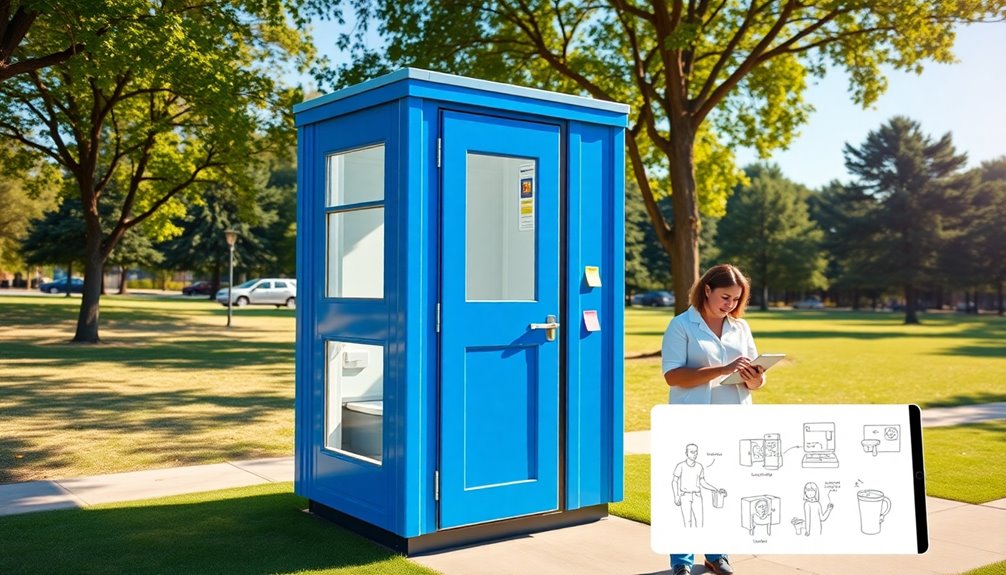
When using portable restrooms, you've likely noticed key areas that could use improvement.
Users often point out the need for better comfort and accessibility, alongside enhanced hygiene and sanitation features.
Additionally, the integration of advanced technology can greatly elevate your experience, making these facilities more convenient and user-friendly.
Comfort and Accessibility Enhancements
As feedback pours in from countless users, it's clear that comfort and accessibility in portable restrooms are top priorities. Users emphasize the need for spacious interiors that mimic traditional bathroom layouts, enhancing usability. Many request ADA-compliant features, such as grab bars and wider entryways, ensuring everyone can access facilities easily. The demand for climate control systems reflects users' desire for comfortable temperatures during extreme weather. Additionally, family-friendly features like changing stations and low sinks cater to parents with young children, aligning with user needs. Implementing these enhancements not only improves user satisfaction but also addresses the importance of financial considerations for elderly care, ensuring that restrooms meet diverse needs.
| Key Focus Areas | User Feedback Highlights |
|---|---|
| Comfort | Spacious interiors, climate control systems |
| Accessibility | ADA-compliant elements, wider entryways |
| Family-friendly | Changing stations, low sinks |
Hygiene and Sanitation Features
To guarantee a safe and pleasant experience in portable restrooms, many users have called for significant improvements in hygiene and sanitation features.
User feedback has led to the integration of hands-free fixtures, like sensor-activated faucets and soap dispensers, which greatly reduce germ transmission. Antimicrobial surfaces have also become popular, inhibiting bacteria growth and enhancing overall sanitation.
Improved flushing mechanisms assure a cleaner experience, addressing user convenience and hygiene. Additionally, the demand for automatic cleaning systems has resulted in units that sanitize after each use.
Real-time monitoring technology detects spills and blockages, allowing for quick servicing. All these design advancements reflect users' desire for higher hygiene standards in portable restrooms, making them safer and more pleasant.
Technological Innovations Integration
While many users have emphasized the importance of hygiene and comfort in portable restrooms, their feedback has also highlighted several key areas for technological innovations.
You'll find that hands-free fixtures, like sensor-activated faucets and soap dispensers, enhance sanitation solutions by minimizing surface contact.
Users also demand automated cleaning systems that activate after each use, maintaining cleanliness effortlessly.
Climate control features, including heating and cooling systems, guarantee comfort during extreme weather.
Additionally, innovative design has led to more spacious interiors and ergonomic layouts, improving usability for everyone.
Finally, the integration of smart monitoring systems allows for real-time usage tracking, enabling responsive maintenance and boosting operational efficiency in restroom fleets.
These advancements truly transform your portable restroom experience.
Enhancements in Comfort and Usability
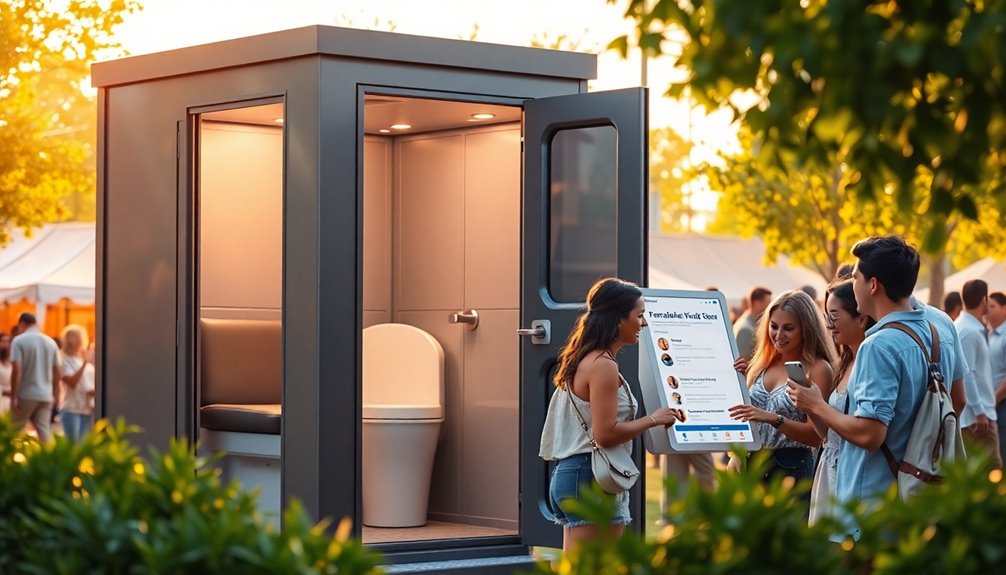
When you step into a modern portable restroom, you'll notice how user feedback has shaped its design for better comfort and usability.
Ergonomic layouts, climate control features, and hands-free technology make your experience more enjoyable and hygienic.
These enhancements not only elevate convenience but also address common concerns about usability in traditional units.
Ergonomic Layout Improvements
As user feedback emphasizes the need for ergonomic layouts in portable restrooms, designers are making significant strides in enhancing comfort and usability.
You'll notice that these improvements focus on user experience, creating spacious interiors that allow for easier mobility, especially for individuals with disabilities or families.
Strategic placement of amenities like sinks and soap dispensers minimizes awkward movements, making your visit more pleasant.
Additionally, enhanced privacy features, such as wider entryways and grab bars, prioritize dignity and accessibility.
By incorporating your feedback, designers guarantee that portable restrooms cater to diverse needs, making them more inviting and functional.
Climate Control Features
How can climate control features transform your experience in portable restrooms? These innovative climate control systems effectively regulate temperature, ensuring comfort in extreme weather—be it sweltering summers or chilly winters.
Thanks to user feedback, modern designs now offer adjustable heating and cooling options, allowing you to personalize your restroom environment. Enhanced insulation materials contribute to better temperature control, making prolonged use much more pleasant.
Additionally, integrated ventilation systems maintain air quality and reduce humidity, minimizing discomfort and odors. Studies show that portable restrooms equipped with these climate control features report markedly higher user satisfaction ratings.
Ultimately, these enhancements not only improve usability but also create a more enjoyable experience for everyone.
Hands-Free Technology Integration
Integrating hands-free technology in portable restrooms markedly elevates comfort and usability.
With sensor-activated faucets and soap dispensers, you can enjoy enhanced hygiene by minimizing surface contact, reducing germ spread.
Foot-pedal flush systems let you maintain cleanliness while eliminating the need to touch handles, promoting sanitation.
User feedback has been essential in designing automatic doors that open and close without physical contact, making restrooms more accessible and convenient for everyone.
Additionally, motion-activated lighting guarantees you have visibility without fumbling for switches.
Data shows a strong preference for touchless operations, prompting manufacturers to prioritize these features in new designs, ultimately leading to improved customer satisfaction.
Hands-free technology truly transforms the portable restroom experience.
Innovations in Hygiene and Sanitation

While traditional portable restrooms often fell short in hygiene, recent innovations driven by user feedback have revolutionized sanitation standards.
You'll notice hands-free fixtures like sensor-activated faucets and soap dispensers that drastically reduce surface contact, cutting down on germ spread. Innovations in flushing mechanisms improve both hygiene and convenience, guaranteeing waste disposal is efficient with minimal water usage.
Antimicrobial surfaces have been introduced to inhibit bacteria, mold, and mildew growth, addressing user concerns directly. Enhanced sanitation standards now include automatic cleaning systems that activate after each use, boosting overall hygiene levels.
Plus, real-time monitoring systems guarantee maintenance needs are met promptly, allowing for swift responses to cleanliness and operational issues. These advancements create a cleaner, safer restroom experience for everyone.
Eco-Friendly Features Driven by Customer Input
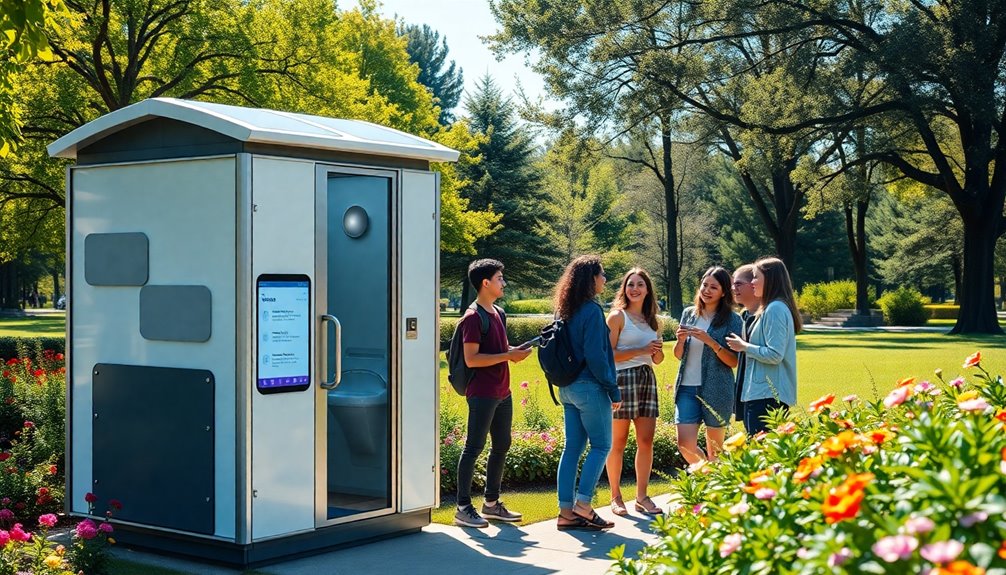
User feedback has sparked a wave of eco-friendly features in portable restroom design, addressing both sustainability and convenience.
You've likely noticed the shift towards biodegradable materials, which considerably reduces environmental impact and waste generation. Customer input has also led to the adoption of composting toilets, transforming waste into nutrient-rich compost and promoting sustainable waste management.
The demand for water conservation is evident in the integration of low-flow toilets and water-efficient fixtures, minimizing water usage without sacrificing performance.
Additionally, manufacturers now offer eco-friendly cleaning products that are biodegradable and non-toxic, ensuring hygiene while protecting the environment.
Finally, user suggestions have influenced the development of solar-powered restroom units, decreasing reliance on traditional energy sources and embracing renewable energy for outdoor events. Furthermore, the water purification methods integrated into these designs ensure that any water used is treated safely, further promoting eco-friendliness.
Accessibility Considerations From User Experiences
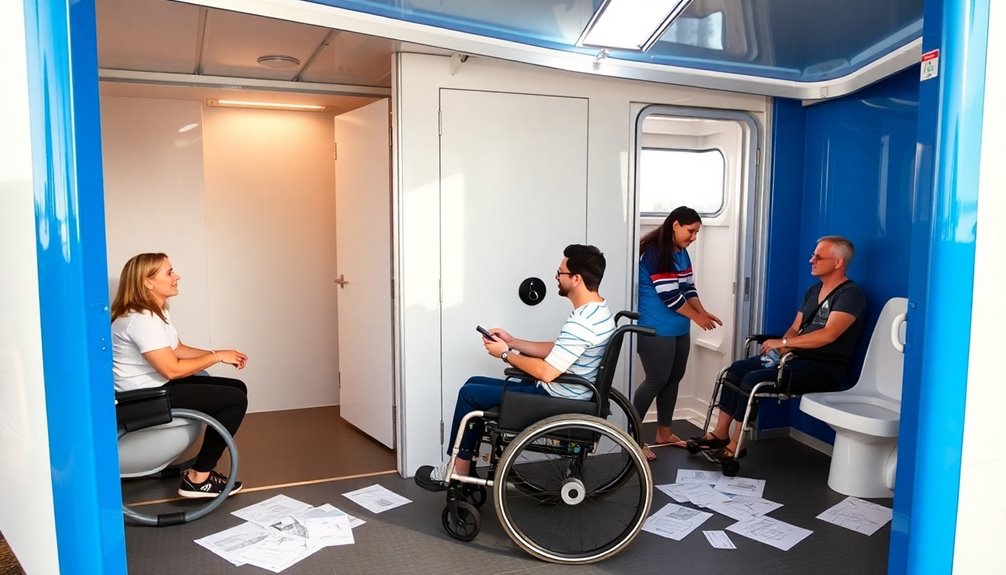
As feedback from individuals with disabilities becomes increasingly vital, portable restroom designs are evolving to prioritize accessibility. Manufacturers are now incorporating ADA-compliant features, such as spacious entryways and grab bars, to guarantee that everyone can use the facilities comfortably.
Wheelchair accessibility is a key focus, prompting the design of restroom trailers with ramps and wider doorways. User experiences also highlight the demand for low sinks and changing stations in family-friendly units, enhancing convenience for caregivers.
Furthermore, clear signage is essential; standardized communication practices improve usability for all. Ultimately, surveys show that user satisfaction rises markedly when portable restrooms include these inclusive design elements, driving the industry to continuously adapt and innovate based on real feedback.
Technological Advancements Inspired by Feedback
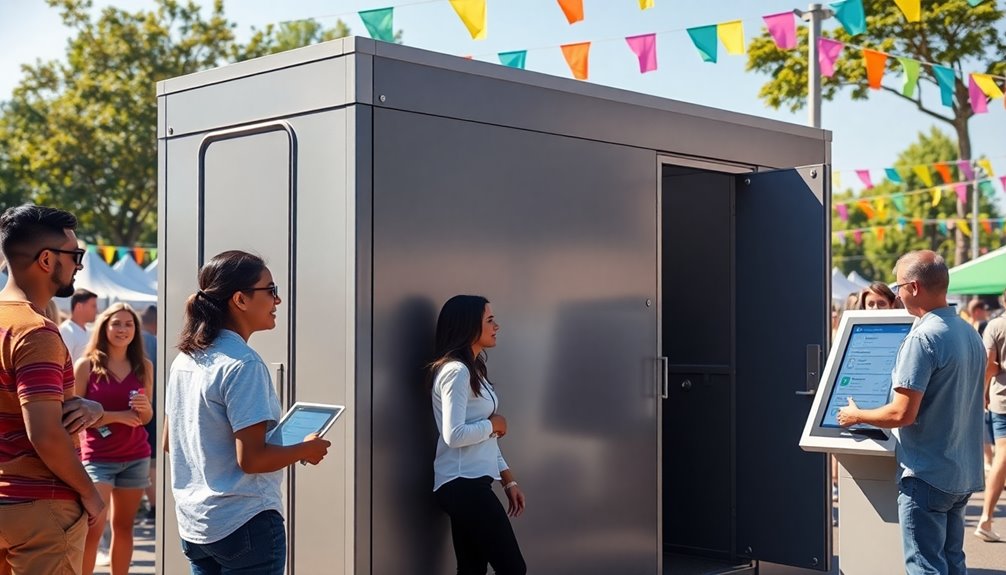
With the rise of technology in everyday life, portable restroom designs are increasingly incorporating user feedback to enhance functionality and hygiene.
Technological advancements driven by this feedback include smart monitoring systems that track usage and maintenance needs in real-time, improving operational efficiency. Users have also inspired the development of hands-free fixtures, like sensor-activated faucets and soap dispensers, which promote better hygiene and minimize surface contact.
Additionally, automated cleaning systems guarantee restrooms are sanitized after each use, raising cleanliness standards. Mobile apps designed for service requests and issue reporting enhance customer engagement.
Furthermore, continuous dialogue with users has led to the use of eco-friendly materials, such as composting toilets and solar-powered units, reflecting a growing demand for sustainability.
Future Trends Shaped by User Insights

While listening to feedback, manufacturers are shaping the future of portable restroom design to better meet user needs.
You'll notice more spacious and ergonomic portable toilets, addressing concerns like claustrophobia. Enhanced hygiene is a priority, with hands-free fixtures such as sensor-activated faucets and soap dispensers becoming standard.
User feedback is also fueling the demand for eco-friendly solutions, including composting toilets and water-efficient designs. Smart technology is making its way into sanitation facilities, allowing for real-time monitoring of availability and maintenance.
As outdoor events continue to grow, innovations like climate control features and improved sanitation standards are essential.
This ongoing dialogue with users guarantees that portable restrooms evolve to meet your expectations and enhance your experience.
Frequently Asked Questions
How Can Users Submit Their Feedback on Portable Restroom Designs?
You can submit your feedback on portable restroom designs through various channels.
Many companies offer online surveys or feedback forms on their websites. You might also find social media platforms useful; just tag the company or use specific hashtags.
Some organizations provide email addresses for direct communication.
If you've used their facilities at events, consider talking to staff on-site, as they often relay user experiences back to the design teams.
What Specific User Demographics Influence Portable Restroom Design Changes?
When it comes to portable restroom design changes, specific user demographics play a big role.
You might find that event-goers, construction workers, and festival attendees have unique needs. Families often prioritize cleanliness and accessibility, while outdoor enthusiasts may seek durability and portability.
Are There Examples of Successful Innovations Driven by User Feedback?
You might think that user feedback for portable restrooms would be limited to complaints about cleanliness and odors, but it’s so much more! In fact, users often share insights about the overall accessibility and functionality of these facilities. Many individuals also comment on the design and features that enhance convenience, such as handwashing stations and adequate ventilation. Ultimately, the quality of portable restrooms and event experience can significantly impact participants’ satisfaction and enjoyment at outdoor gatherings.
Innovations like hands-free doors and solar-powered lights arose from suggestions that seemed trivial at first. Users wanted convenience and sustainability, and companies listened.
These changes not only enhance the experience but also show how valuable your input can be in reshaping even the most unexpected products.
How Often Do Manufacturers Update Designs Based on User Input?
Manufacturers typically update designs based on user input regularly, often every few years or even sooner if significant feedback arises.
You'll find that many companies prioritize customer satisfaction, so they're keen to adapt their products quickly.
By actively listening to users, they can identify issues and implement improvements that enhance functionality and comfort.
It's a dynamic process, ensuring that designs stay relevant and meet changing needs in the market.
What Role Do Events Play in Shaping User Preferences for Restrooms?
Events play a significant role in shaping your preferences for restrooms. When you're at a festival or sporting event, you notice what features matter most, like cleanliness, accessibility, and comfort.
Your experiences at these gatherings influence your expectations for future facilities. You might find yourself favoring restrooms with proper ventilation or spacious interiors.
As you share these insights with others, you contribute to a broader understanding of what makes a great restroom experience.
Conclusion
In the ever-evolving world of portable restroom design, your voice matters as much as Da Vinci's brush strokes on canvas. By sharing your experiences, you're not just offering feedback; you're shaping the future of comfort and convenience in sanitation. As designers listen and adapt, the industry transforms into a more user-centric landscape, ensuring that every restroom experience is not just functional, but also a step toward innovation. Together, you're paving the way for a cleaner, greener tomorrow.
